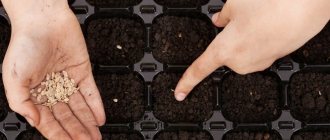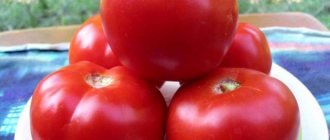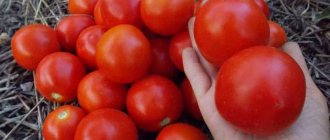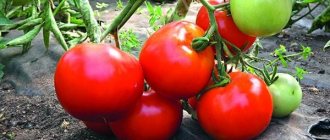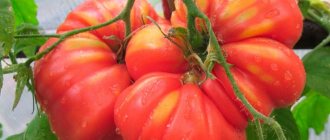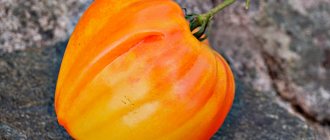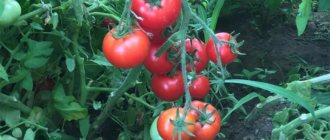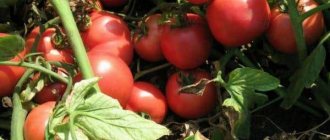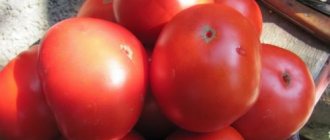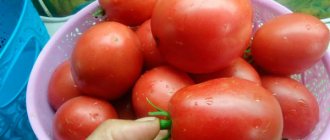Breeders always develop new varieties of tomatoes taking into account the wishes of vegetable growers. Dutch experts offered farmers a wonderful variety with record yield, endurance and extraordinary taste. We are talking about the mid-season hybrid “Palenka”.
The Palenka tomato deserves attention due to its characteristics that meet the needs of even very demanding vegetable growers. This is confirmed by reviews from summer residents and photos of mature Palenka tomato bushes.
Main characteristics
The description of the Palenka tomato variety must indicate important characteristics. This is a list of the advantages and characteristics of tomatoes that vegetable growers should take into account when growing the variety. Basic information for summer residents is:
- Type of plant. The tomato is a first generation hybrid, therefore it is marked with the letter F1 on seed packets.
- Type of tomato bush. According to the description of the variety, the Palenka tomato belongs to indeterminate plants. This means that the bush of a plant with an endless growth process reaches a height of up to 2 meters. Therefore, the vegetable grower will need the ability to shape, tie and shoot tomatoes.
- Type of cultivation. The hybrid is recommended for cultivation in a greenhouse. Some hobbyists try to grow the plant in open ground, but in this case it is not possible to obtain all the qualities declared by the manufacturer.
- Harvest ripening period. Mid-early. After the seeds germinate, no more than 110 days pass until the fruits of the Palenka variety are fully ripe.
- Appearance and parameters of the Palenka tomato bush. The plant forms into one stem, which grows very powerful, there are no branches. Requires tying to a trellis. Carpal fruiting. The first cluster of tomatoes is formed after the 9th leaf; 5-6 tomatoes ripen in each cluster. The following tassels are tied regularly after 2-3 sheets.
- Fruit. Symmetrical glossy cream. The color of ripe Palenka tomatoes is bright red. The fruits have a rich taste and aroma. The weight of one tomato is 100-110 g. They tolerate transportation and storage well and do not crack when moved. Equally well suited for fresh consumption and preparations. They are used by housewives for canning whole fruits, making juices, purees and salads. It is highly valued by farmers for the quality of its fruit.
- Resistance to crop diseases. The hybrid tomato variety demonstrates good resistance to Verticillium and Fusarium wilt of roots, TMV, and cladosporiosis.
- Productivity is one of the most important characteristics of Palenque tomatoes. Many vegetable growers consider this indicator the most significant. With good care, 20 kg of high-quality fruits are harvested from one square meter of tomato planting area.
According to reviews from vegetable growers, the yield of the Palenka tomato variety covers all the hassle of growing the plant.
Description of the hybrid
Palenca is a hybrid, not a tomato variety. Its characteristics and description indicate high productivity even in unfavorable conditions. The plant is indeterminate, with unlimited growth of the main stem.
The height reaches 2 m and therefore requires gartering and pinching of plants. The foliage is medium, the leaves are rich green, the branches are spreading. The first flower cluster is placed above the 9th leaf, subsequent ones every 2-3 leaves. Each brush produces 5–7 ovaries in all weather conditions.
Mid-early species: harvesting begins 105–115 days after emergence. Tomato is immune to a number of dangerous diseases, such as:
- tobacco mosaic virus;
- fusarium and verticillium leaf wilt;
- cladosporiosis (brown spot);
- root rot.
These diseases have different etiologies: viral and fungal. Both are equally dangerous for plants. During an outbreak of infections, most of the plantings die. When damaged by fungi, seedlings can be cured by identifying the disease at an early stage. However, a viral infection is practically untreatable. Therefore, a big plus for any culture is its immunity.
In addition, neighboring plants can also become infected, as happens with brown spot, tobacco mosaic, fusarium and verticillium. With these diseases, the appearance of the leaves and their color are modified. Subsequently they wither and the plant dies. Root rot causes rotting of the roots and death of stem tissue.
Despite Palenca's strong immunity against many dangerous diseases, it is practically not protected from late blight. Therefore, you should take care of the necessary preventive measures in advance.
Yield indicators
The culture is recommended for cultivation under film cover and in greenhouse conditions. Nevertheless, in the southern regions, tomatoes are successfully grown in open beds, although under such conditions high fruiting rates cannot be achieved.
Reference . The creator of the hybrid claims high productivity only in closed ground.
When planted in a greenhouse, 6-7 kg of excellent fruits are collected from 1 seedling, provided that no more than 3 plants are planted per 1 m2.
Description of fruits
The photo shows Palenque tomatoes.
The average weight of ripe tomatoes is 100–130 g, oval in shape, slightly elongated, similar to cream. The color is deep red, the taste is excellent, sweet, with a pronounced sourness characteristic of tomatoes.
The pulp is juicy and dense. The peel is thin, but strong enough for long-distance transportation. During long-term storage, vegetables retain their presentation. For these reasons, the variety is a success among entrepreneurial farmers who grow it on an industrial scale. Ripe tomatoes are in great demand in markets.
The purpose of the fruits is universal: they are suitable for preparing various fresh dishes, winter preparations and processing into tomato products.
Advantages and disadvantages
Any vegetable crop has advantages and disadvantages. Their list can be compiled based on the reviews of those summer residents who have already grown the Palenka F1 tomato.
Advantages of tomato:
- unpretentiousness in any climate zone;
- evenness and uniformity of fruits;
- excellent taste;
- high and stable yield;
- excellent commercial quality;
- versatility of use;
- high indicators of keeping quality and transportability.
Summer residents also highlight some disadvantages of Palenka tomatoes:
- the need for pinching and formation of bushes;
- the need to install trellises and tie the stem;
- susceptibility to late blight;
- cultivation only in closed ground.
Those who have already grown indeterminate tomatoes in a greenhouse consider such parameters to be features of the agricultural technology of the Palenka variety. All the troubles are offset by the number of fruits. The yield of tall varieties of tomatoes is much higher than that of low-growing varieties. In addition, the yield of the harvest does not occur in 1-2 doses, but spread out over the entire season. According to reviews from farmers, the yield of the Palenka tomato in the greenhouse is very high, each bush is literally strewn with fruits (see photo).
Palenque tomatoes on video
If you grew Palenque tomatoes, please write what the yield and taste of the fruit were in your climatic conditions? Do you know better hybrids suitable for canning? Briefly describe the advantages and disadvantages of this tomato in your opinion. If possible, attach to your review a photo of the entire bush as a whole or individual fruits you grew. Thank you!
Your reviews of the Palenque tomato and additions to the description will help many gardeners evaluate this hybrid objectively and decide whether it is worth planting or not.
Growing a hybrid - first steps
In order for tomatoes to begin to bear fruit earlier, the seedling method of cultivation is used. The technology for growing indent seedlings is almost no different from cultivating low-growing varieties. Sowing of Palenka tomato seeds is scheduled for mid-March so that the seedlings do not outgrow. If the planting material was purchased from a trusted supplier, then the licensed seeds have undergone pre-sowing treatment. In this case, the vegetable grower’s task is to take care of the quality of the substrate.
For tomato seedlings “Palenka F1”, a mixture of humus, turf soil and peat is prepared. The components are taken in equal quantities. Additionally, add 1 teaspoon of fertilizer to each bucket of the mixture:
- superphosphate;
- urea;
- potassium sulfate.
If the components are not prepared in advance, then buy ready-made soil mixture for seedlings. It has an optimal composition and sufficient nutrients.
Separately, it should be said about the choice of containers for indent seedlings. You can sow it in a box, and at the two-leaf stage, pick it out in separate cups. But it is better to take special cassettes in which the bottom extends. This will help transfer the seedlings into a larger container without damage. The container for seedlings of the tall Palenka tomato should be spacious so that the plants do not start growing in cramped conditions. Otherwise, the yield will decrease significantly.
Important! It is better to grow a few Palenca tomato roots in spacious containers than a lot in cramped spaces.
The prepared container is filled with soil mixture and sowing begins. Tomato seeds of the “Palenka” variety are buried in the soil no more than 1.5 cm. Sprinkled with a thin layer of soil and covered with film.
Many vegetable growers are concerned about the ambient temperature values. According to the description of the Palenka tomato variety, the optimal temperature for:
- Seed germination is +23°C-+25°C. To maintain the value at a constant level, the planting containers are covered with film. As soon as shoots appear, the film must be removed.
- The first period of seedling growth remains within the same limits. After 2 weeks, reduce the indicator to 20°C. This is achieved by ventilating the seedlings.
- Disembarkation time is +18°C - +19°C.
Important! If you grow seedlings of the indeterminate variety “Palenka” at lower temperatures, the establishment of the first cluster will occur too low.
Recommendations for cultivation
For seedlings, experienced gardeners advise planting seeds in the second ten days of March. Before planting, it is recommended to treat the seeds with a solution of potassium permanganate.
Picking is best done when the third true leaf appears. It is advisable to combine it with fertilizing with mineral fertilizer containing copper. Before planting seedlings, it is recommended to add a handful of crushed egg shells into the hole. After planting, water abundantly with water at room temperature.
Read useful articles about fertilizers for tomatoes:
- Organic, mineral, phosphorus, complex and ready-made fertilizers for seedlings and the TOP best.
- Yeast, iodine, ammonia, hydrogen peroxide, ash, boric acid.
- What is foliar feeding and when picking, how to carry it out.
Seedling care
The main points that a vegetable grower must carry out in a timely manner:
- watering;
- feeding;
- dive;
- ventilation;
- disease prevention.
Water the seedlings carefully and with warm water. According to the description of the properties of the variety, tomato seedlings “Palenka are moistened infrequently, but only after the top layer of soil has dried (see photo).
Plants dive in the two-leaf phase. Spacious containers are prepared in advance, filled with soil and seedlings with a lump of earth are transferred. In this case, the stem is buried down to the cotyledons.
Feeding is done according to the schedule. Seedlings need nutrition so that adult plants bear fruit better. The first time seedlings need feeding is a week after picking. Palenka tomatoes respond well to watering with an aqueous infusion of humus (10:1). After 7 days, water the seedlings with mineral fertilizers:
- urea – 0.5 tsp;
- superphosphate – 1 tbsp. l.;
- potassium sulfate – 1 tsp.
The substances are diluted in 5 liters of clean water and fed to tomato seedlings. It is more convenient to purchase ready-made complex fertilizer and dilute it according to the instructions.
2 weeks before planting, seedlings begin to harden to adapt the plants to the temperature inside the greenhouse. Seedlings of indeterminate varieties are ready for planting when they have 9 true leaves.
Features of growing the variety
Seedlings grow for quite a long time, so seeds for seedlings begin to be planted 2.5-3 months before the planned transplantation into the greenhouse. In the middle zone this is the end of February, in the south - the beginning of the month, and in the Urals and Siberia - the first days of March.
It is better to purchase soil in a store. Although it can be composed independently - for example, based on turf soil, peat and compost (2:1:1) with the addition of superphosphate and potassium salt in equal quantities. Before planting, several preparatory work should be carried out:
- Disinfect the soil with a weak solution of potassium permanganate or hydrogen peroxide.
- Immerse the seeds in a 5% salt solution and remove any that float. Keep them in a stimulator for several hours - “Epin”, “Kornevin”, “Zircon”.
- Prepare wooden or plastic containers, soak them in an antiseptic or pour boiling water over them, then lay a drainage layer (small stones) and the soil itself.
Palenca tomato seeds are planted to a depth of 1 cm, an interval of 3 cm. Then they are generously sprayed with a spray bottle, covered with a transparent lid and placed in a warm place at a temperature of 24-26 degrees. In this mode they are grown in the first 2 weeks from the moment of emergence.
Then the temperature is reduced to 20 degrees. When 2-3 leaves appear, dive into individual containers. A week later, water with complex fertilizer, and for the remaining days the temperature is maintained at no more than 19 degrees. 2 weeks before transplanting, Palenca tomato seedlings can be hardened off at 15-16.
In most regions of Russia, Palenque tomatoes are grown in a greenhouse
Plants are transplanted into the greenhouse at the end of May, when the temperature in the ground layer is above 17-18 degrees. Further care is standard - watering 2 times a week, fertilizing with complex fertilizer and wood ash 2 times a month, mulching with peat, humus or sawdust, weeding, loosening the soil. The bush must be pinched and tied to a support.
Planting in a permanent place and caring for plants
It is important for the gardener to adhere to the timing of planting the Palenka tomato in the greenhouse and the planting scheme. For closed ground, the planting density of tomatoes is no more than 3 bushes per 1 square meter. meter.
Advice from an experienced gardener on planting tomatoes in a greenhouse:
After a week, when the plants have taken root, the stems are tied to a vertical trellis with twine. Subsequently, every 3-4 days the main stem is braided around the twine. This technique prevents Palenka tomatoes from sliding down under the weight of the fruit.
The temperature in the greenhouse must be maintained. With sharp temperature fluctuations, tomato bushes of the Palenka variety can shed their ovaries. To prevent this from happening during the fruiting phase, the soil must be heated to 18°C, the air to 25°C during the day and 18°C at night.
It is also important to provide good lighting. Proper formation of the stem helps to avoid thickening of the bushes.
Useful video on this issue:
Another point that you need to pay attention to is the air humidity in the greenhouse. If waterlogging cannot be avoided, Palenka tomatoes may become susceptible to fungal diseases. Therefore, water the plants no more than 2 times a week, then loosen the soil and ventilate the room.
Important! It is necessary to remove the lower and old leaves up to the first cluster in order to improve the ventilation of the bushes.
The leaves are torn only to the side. If you do this in a downward direction, you can injure the stem.
Fertilizing for the variety is carried out regularly, alternating every 2-3 weeks. Palenka tomatoes need the first feeding 2 weeks after planting in the greenhouse. For all fertilizing, complex mineral fertilizer is used. The consumption of the working solution is 0.5 l per area of 10 square meters. m.
Pest and disease control
The immunity of Palenque tomatoes is very good. But experienced summer residents always treat seedlings with a fungicide a week before transplanting into the ground. For this you can use any drug:
- Bordeaux mixture;
- "Fundazol";
- "Ordan";
- "Tattu";
- "Profit";
- "Fitosporin".
Insects can be quickly killed with insecticides:
- "Aktellik";
- "Match";
- "Ephoria";
- "Fitoverm";
- "Confidor";
- "Fufanon."
Home remedies are also great - for example, a decoction of potato tops, a solution of baking soda, ammonia, an infusion of onion peels, garlic, chili peppers, mustard powder and others.
Advice! Processing of Palenca tomato bushes is carried out late in the evening, in dry and windless weather (when grown in open beds). If chemicals are used, fruits can only be harvested after a few days.
Useful tips
For gardeners who are growing Palenka tomato varieties for the first time, it will be useful to remember the advice of professionals:
- For a hybrid, you must carefully follow the watering schedule. One miss, and the fruits crack and become smaller. During the period of active fruiting, the schedule does not change for indents. Therefore, watering is not reduced to ensure intensive fruit set.
- It is better to form plants into one stem. This ensures good illumination and ventilation of the Palenka bushes.
- It is necessary to root the plants. Otherwise, the uncontrolled growth of stepchildren will lead to the formation of a jungle in the greenhouse with all the ensuing consequences - diseases, reduced yields and weakened tomatoes.
- If the requirements of the variety's agricultural technology are not followed, the plants are susceptible to late blight.
- The formation and pinching of plants is done throughout the entire growing season.
Gastronomic features
Expressive tomatoes of the Dutch variety are distinguished not only by their European origin, ripe berries:
- The shape of an elongated oval, reminiscent of cream. The skin, which protects the juiciness of the pulp, is dense and glossy.
- The weight of a ripe tomato varies from 120 to 150 grams, the fruits are light.
- The skin of the ripe berry is of a contrasting red hue, the leaves are oval and small.
- The product withstands transportation without complications and has a marketable appearance.
- The fruits of the Palenca variety are actively used in cooking, often becoming the main component of marinades and pickles.
On thematic sites, in a heap of reviews from those who grew them, there are descriptions of the taste and aroma of ripe tomatoes. Tomato as one of the ingredients in a dietary salad adds a pleasant sour taste to the dish.
Features of agricultural technology and reviews of the hybrid
Pre-grown tomato seedlings are transplanted into a greenhouse when the soil has already warmed up, placing no more than 3-4 plants per 1 m2. Some vegetable growers simply plant bushes in the garden without shelter, but in this case the yield will be less than declared.
It is recommended to form tomatoes into 1 stem. All lateral shoots are removed, as well as the lower foliage up to the first cluster. In care they are practically no different from other tomatoes.
Advice. Particular attention should be paid to watering so that moisture is supplied to the plants regularly.
Reviews about the tomato are good:
- Elena from Shebekino noted that tomatoes have only one drawback - the difficulty of purchasing seeds. She liked everything else.
- Nadezhda from Navashino appreciated the crop for its fertility. Only a few bushes were planted, but the harvest was enough for the whole family.
- Vitaly from Pervouralsk liked the hybrid for its wonderful taste, versatility of use, and friendly harvest ripening.
The Palenca tomato is an excellent hybrid. But it is not suitable for those summer residents who rarely come to their garden plots, since in the absence of regular watering, the ovaries may be shed and the shell of the fruit may crack.
Growing tomatoes
To obtain an earlier harvest, tomatoes are grown through seedlings.
How to prepare seeds?
Before sowing, seed material must be disinfected using a manganese solution. After which it is placed in a damp cloth for 24 hours.
REFERENCE: Seed material purchased from a specialized store does not need to be additionally prepared.
Sowing seed material
Recommendations for sowing seeds:
- The composition of a self-prepared soil mixture should include humus, turf soil and peat (in equal proportions). You also need to additionally add superphosphate, urea and potassium sulfate (a teaspoon each). However, it is better to use a ready-made substrate, since it has an optimally selected composition of nutrients;
- For sowing, it is better to use special cassettes with a retractable bottom to prevent possible damage during transplantation into a more spacious container;
- The containers are filled with substrate and the seeds begin to be sown using the following scheme: in a row every 3-4 cm, between rows from 8 to 10 cm. The sowing depth of seed material is no more than 1.5 cm. Sprinkle a thin layer of earth on top and cover the plantings with film;
- As soon as two true leaves appear, they begin picking, deepening the stem to the cotyledons;
- Warm water is used to water the seedlings. Watering is carried out with caution. Do not allow the soil to dry out;
- 10-14 days before the planned planting, they begin to harden the seedlings so that the plant acclimatizes to greenhouse conditions.
Growing tomatoes on a windowsill:
Rules for planting seedlings
How to plant seedlings correctly:
- Seedlings with 4-5 leaves, a stable stem and a strong root system are planted. Generally, planting is carried out at the end of April - beginning of May, in well-warmed soil;
- To disinfect the soil, it is spilled with a manganese solution. Before planting, two liters of a mixture of humus and peat and a glass of wood ash are added to the planting holes. And then you need to add warm water to them to form liquid mud. It is in it that the seedlings are planted, with a depth of three centimeters. Planting of seedlings is carried out according to the traditional scheme for greenhouse structures - 50x50 or four bushes per 1 m2;
- Near the bush, the soil is compacted and mulched with dry soil.
ATTENTION: Watering seedlings immediately after planting in a greenhouse structure is not recommended. Otherwise, a crust will form on the surface of the earth.
